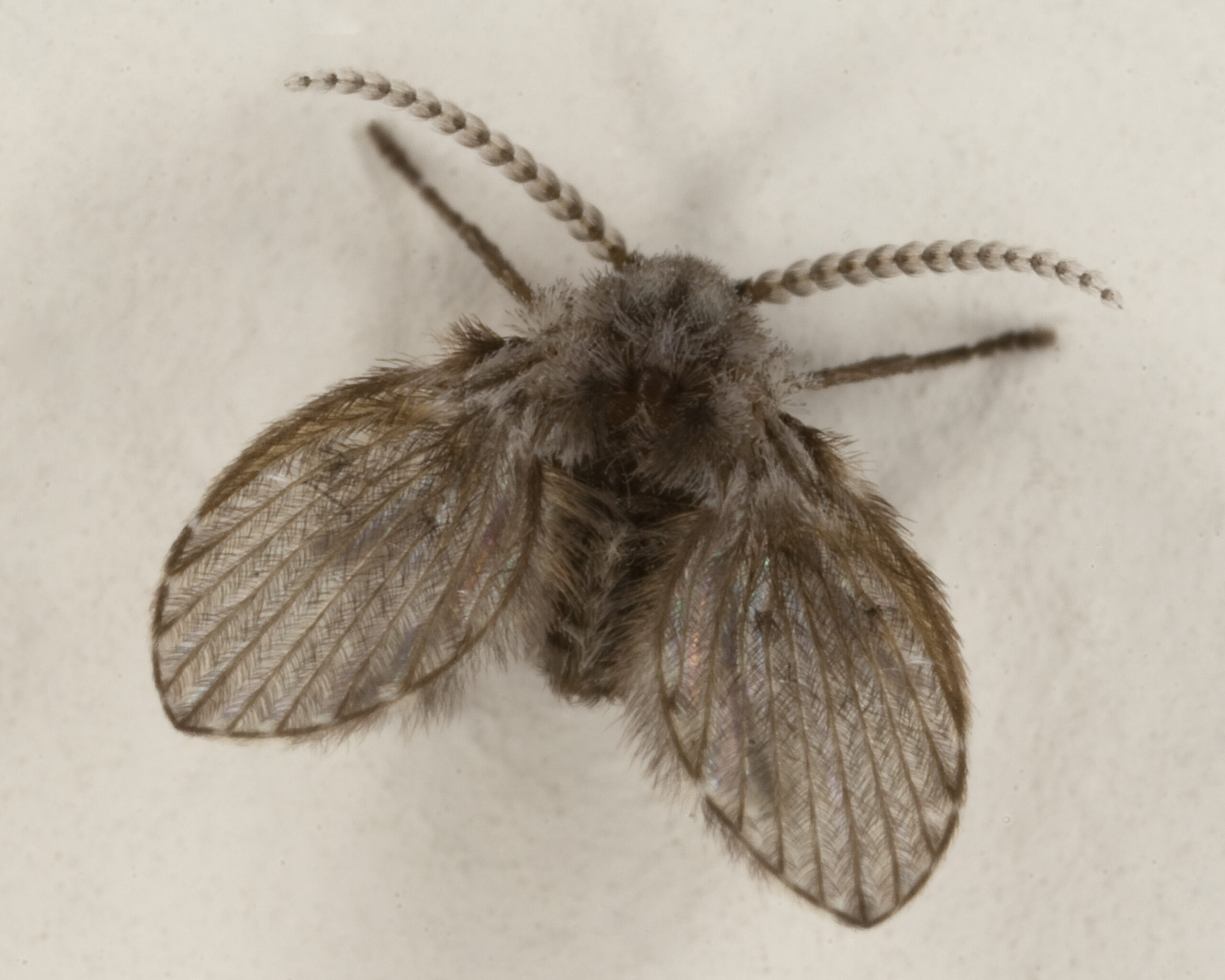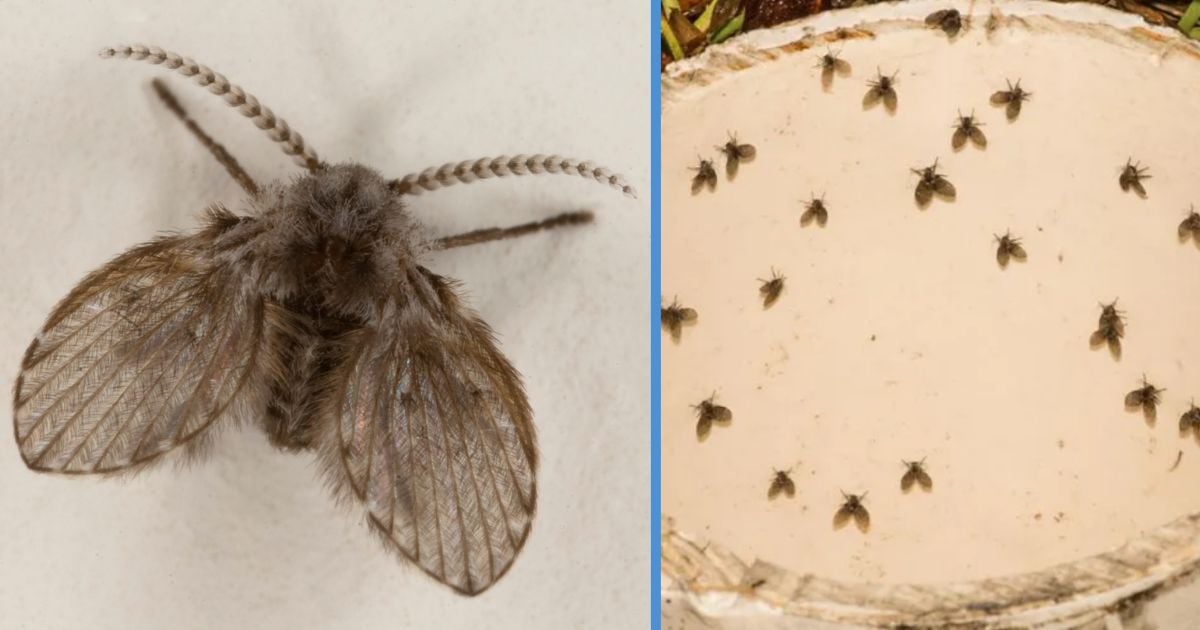You know those small pesky flies that always show up in your drains and never go away? They’re also often in your toilets, too.

They belong to the Psychodidae family, and I think they’re psycho for never leaving.
Here are 10 facts about these annoying little insects.
How Drain Flies Really Look Like
Drain flies are teardrop-shaped and are only about 1.5 to 5mm long.
These light grey, tan, or brownish-black insects have a hunchbacked appearance, with a round body and large wings held roof-like over the body when at rest.
Their wings and body are covered in fine hairs, giving them a moth-like appearance. This is why they are sometimes called “moth flies”.
They Thrive in Toilets
Their larvae live in aquatic to sludge-based habitats, including bathroom sinks. They feed on bacteria and grow.
This means that toilets offer these pests the perfect breeding ground.
Drain fly larvae can sometimes be seen moving along the moist crevices in shower stalls or bathtubs or submerged in toilet water.
Gross.
In small numbers, their larvae can sometimes be considered beneficial as their strong jaws can cut through the hair and sludge waste in drains which might otherwise form clogs.
However, unless this sludge layer is removed entirely, the adult flies will continue to find it and lay more eggs.
Insane Reproductive Power
Adult female drain flies lay their eggs in gelatinous films within wet, decaying organic matter like the sludge lining drains.
One adult female drain fly is capable of laying up to 100 eggs at once.
That’s pretty horrifying news.
As soon as an adult fly emerges from the breeding site, it starts to seek mates to breed right away.
I guess this is why you can never really get rid of them.
They Only Live Two Weeks
The life cycle of drain flies is extremely fast.
After an adult female lays eggs in sludge around sewage and drain areas, the eggs hatch in 32 to 48 hours.
The larvae are worm-like and feed on the organic matter in drains. This stage lasts anywhere from eight to 24 days before they enter the pupal stage.
Larvae encase themselves for transformation which lasts 20 to 40 hours.
After this, they emerge as adult flies and continue to infest sludge areas before they die about two weeks later.
Types of Drain Flies
The term “drain fly” can apply to three different groups of insects, but it usually refers to the moth fly (Psychodidae). These are commonly found in bathroom and kitchen drains, feeding on the organic gunk lining the pipes.
Phorid flies (Phoridae), are tiny, dark-colored with a characteristic hump-backed appearance. Since moth flies and phorid flies are both very small, it can be hard to tell them apart. Phorid flies breed in a wider range of decaying matter, including overripe produce, garbage, or very moist, potted plant soil.
Fruit flies (Drosophila Melanogaster) have distinctive red eyes. These flies are drawn to sugary substances and fermenting fruits and vegetables. Can sometimes lay eggs in moist areas as well.
Out of these three, the moth fly is the insect most closely associated with being a drain fly.
Drain Flies Are Not Good Fliers
Have you noticed that drain flies usually rest on walls?
When disturbed, they simply hop a few centimetres over and rest on the wall again instead of flying around.
While their wings look large compared to their bodies, they don’t provide ample lift or stability. They tend to flutter erratically with short, hopping movements instead of smoothly gliding.
The fine hairs covering their bodies and wings also create wind resistance, slowing them down and making it more challenging to control their direction.
Drain flies typically inhabit tight, enclosed spaces like drainpipes. Hence, they don’t require strong flight capability to get around their usual habitat.
As a result, they simply “jump” or fly short distances.
They Are Generally Not Harmful
Drain flies are not known to bite, sting, or transmit diseases to humans.
However, if they die in your home, their decaying bodies can cause allergic reactions in some people.
People with severe asthma may have trouble breathing because of the dust and fragments from their bodies, as well.
Moreover, since they breed in decaying matter, they could potentially land on food or surfaces and carry bacteria with them. In settings like hospitals where drains might harbor dangerous bacteria, they could act as a mechanical vector of those pathogens.
These Flies Are Commonly Found in Nature
The Psychodidae (moth flies) family includes over 2,900 described species worldwide. Most don’t inhabit drains in our homes.
Since these flies require very moist places to live, such as stagnant puddles of water, they thrive in compost piles or water bodies in nature.
Water bodies formed by terrestrial plants, including treeholes, often see a build up of organic matter which feeds the drain fly larvae.
Drain flies are well-adapted to harsh, fluctuating conditions, flourishing in both sewers and natural settings.
Blood Feeding Sand Flies
Females of the subfamily Phlebotominae, commonly called sand flies, are vicious blood feeders.
These guys are like kinda the “cousins” of drain flies.
The pain of their bites isn’t the biggest concern, however, as they can transmit many diseases through these bites.
Leishmaniasis, bartonellosis, and Pappataci fever are the most severe, with leishmaniasis infecting millions of people and causing 20,000 to 50,000 deaths per year.
You know how these flies never truly go away, no matter what you do?
It appears even an asteroid couldn’t kill them.
Fossil Psychodidae date back to the late Triassic/early Jurassic, which means they were around when the earliest dinosaurs were alive (even before Stegosaurus and most other familiar species).
They would survive an apocalypse.



